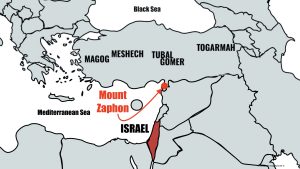If, as we discussed last week, Gog of Magog is not from Russia, then where is he from? And who were the nations mentioned in Ezekiel 38 and 39?
Let’s get the easy ones out of the way first: Persia is Iran, Cush is Ethiopia and/or Sudan, and Put is Libya. That’s simple and well-documented from ancient sources. However, while present-day Iran is clearly an enemy of Israel, it’s hard to see Ethiopia and Libya as part of a terrifying end-times army. In fact, Libya hasn’t been a functioning state since NATO took out Muammar Qaddafi during the Obama administration.
The other players are harder to pin down because their names have faded from history. There are no ambassadors at the United Nations from Magog, Meshech, Tubal, Gomer, and Beth-Togarmah. But we know where on the globe Ezekiel was pointing. All of them are place names in what used to be called Anatolia, which is modern-day Turkey.
Our first clue is chapter 10 of Genesis. We find all these names in the Table of Nations:
The sons of Japheth: Gomer, Magog, Madai, Javan, Tubal, Meshech, and Tiras. The sons of Gomer: Ashkenaz, Riphath, and Togarmah. The sons of Javan: Elishah, Tarshish, Kittim, and Dodanim. From these the coastland peoples spread in their lands, each with his own language, by their clans, in their nations.
Genesis 10:2–5, ESV (emphasis added)
The Hebrew name Gomer probably refers to the Cimmerians (Akkadian Gimirru, which means “complete”), who migrated south from the Eurasian steppes and attacked Assyria in the late seventh century BC. The Assyrians called them Gimmerai; the Cimmerian king Teushpa was defeated by Assarhadon of Assyria sometime between 681 and 668 BC.[1]Because of the military power of the Assyrians, the Cimmerians usually raided west, into Anatolia. They conquered the kingdom of Phrygia in what is today west-central Turkey, thus putting an end to the reign of the legendary king Mita, better known to us by his Greek name, Midas.[2] The Cimmerians eventually settled in Cappadocia in what’s now eastern Turkey and gradually faded from history after the seventh century BC.
Beth-Togarmah, or “House of Togarmah,” was apparently referred to in Assyrian texts as Til-garimmu.[3] The Assyrian king Sennacherib campaigned against the city in 695 BC. Hittite texts refer to a city and district of Tegarama on the upper Euphrates in Turkey, which was captured by their king Suppiluliuma along with other parts of the kingdom of Mitanni, in the mid-fourteenth century BC.[4] Again, the location is within modern Turkey.
Like Beth-Togarmah, Meshech and Tubal are mentioned earlier in the Book of Ezekiel, in chapter 27, alongside Javan (Greece) in a list of trading partners of the Phoenician city-state of Tyre. Akkadian texts mention tabal and mushki, nations in eastern Asia Minor—Turkey. Tabal was a landlocked kingdom between the Halys River and the Taurus River in Asia Minor, bounded on the west by Meshech and by Beth-Togarmah on the east.[5]
Two different groups were called Mushki in Assyrian sources, one from the twelfth to the ninth centuries near the confluence of the Murat and the Euphrates (“Eastern Mushki”) and the other from the eighth to the seventh centuries in Cappadocia and Cilicia (“Western Mushki”).[6] By now, you’ve guessed that both of those regions were in modern-day Turkey.
The men of Meshech first appear in secular history around 1100 BC in the Prism Inscriptions of Tiglath-pileser I, king of Assyria. The Assyrian king tells of fighting five kings of the Mushki, who’d led a coalition south from what is today Armenia to threaten the security of the core of Assyria.[7] The Mushki appear in the records of later Assyrian kings, but most often in the Annals and Pavement Inscriptions of Sargon II (722–705). Their king, Mita (Midas), was apparently a formidable adversary. The Assyrians formed military alliances and built border fortresses specifically to punish these warlike people.
Interestingly, the war between Assyria and the Mushki was over control of Tabal, a strategically important buffer state between the two. After long years and many battles, the Mushki were finally forced to submit and pay tribute. Then the Cimmerians invaded, and it was “game over” for Midas.[8]
As for Magog: Not to get ahead of ourselves, but Ezekiel 39:6 gives us a clue to the location of Magog’s homeland. The war will bring “fire on Magog and on those who dwell securely in the coastlands.” This points to western Asia Minor and the islands of the Aegean—in other words, Javan (Greece). Remember, Genesis 10 tells us the sons of Japheth include Javan and Tiras, who is often identified as the father of the Teresh, one of the Sea Peoples who swarmed from the Aegean[9] and overran much of the eastern Mediterranean around 1150 BC. Ultimately, the Tirasians appear to have migrated west to Italy and established the Etruscan civilization.[10]
In other words, based on the promise of its fiery doom, we should look for Magog along the coastlands of the Aegean, western and/or southwestern Turkey.
Some scholars cite Josephus, the Jewish historian of the first century A.D., as a source for the Russian connection to Magog. Josephus believed Magog referred to the Scythians,[11] a nomadic people who occupied the lands north of the Black Sea for most of their history. However, in Ezekiel’s day, the Scythians had pushed southward across the Caucasus mountains into what is now Armenia, Turkey’s eastern neighbor. So, even if Josephus, who wrote six hundred years after Ezekiel, was correct to link Magog to the Scythians, Ezekiel was still pointing to Anatolia, not the Eurasian steppe.
In short, the people Ezekiel saw coming from the north against Israel in the last days will be from Turkey, not Russia.
And that begs the question: If Russia is not the rally point for the hordes of Magog, then where is it? The problem of identification is compounded by an overly literal interpretation of English translations of Ezekiel 38:6, which describe a place in “the far north,” “the uttermost parts of the north,” “the remote (or remotest) parts of the north,” or “the north quarters.”
The key is not to look at a map, but at the Hebrew—and then at a map. You see, based on the original language, we should be looking at cosmic north—supernatural north—rather than the northernmost country from Israel on a map. The phrase in Ezekiel 38:6, which is repeated in 38:15 and 39:2, is one we mentioned earlier: yarkete tsaphon. It is used only two other places in the entire Old Testament. Examining those uses might shed some light on just where Ezekiel located “the uttermost parts of the north.”
First, Psalm 48:
Great is the LORD and greatly to be praised
Psalm 48:1–2, ESV (emphasis added)
in the city of our God!
His holy mountain, beautiful in elevation,
is the joy of all the earth,
Mount Zion, in the far north,
the city of the great King.
You have to read between the lines, but this passage is a polemic against Baal. As mentioned earlier, everyone in the ancient world knew that Mount Zaphon, the modern Jebel al-Aqra, on the Mediterranean coast near the border with Syria, was the home of Baal’s palace. In the 48th Psalm, Yahweh’s mount of assembly (Zion) is compared to Baal’s (Zaphon) through of clever wordplay: har Tsiyon yarkete Tsaphon:
Psalm 48 makes a bold theological statement. It evicts Baal from his dwelling and boots his council off the property. The psalmist has Yahweh ruling the cosmos and affairs of humanity, not Baal. Psalm 48 is a backhanded smack in the face to Baal.
So is Isaiah 14.[12]
Yes, we’re back to that famous section of Isaiah. I cannot emphasize enough the importance of the 14th chapter of Isaiah to understanding the nature of the supernatural war and the prophecies of what will come in the last days. At the risk of boring you, here it is again—because this is the only other place in the Bible that mentions yarkete tsaphon:
“How you are fallen from heaven,
Isaiah 14:12–15, ESV (emphasis added)
O Day Star, son of Dawn [Lucifer, son of the morning]!
How you are cut down to the ground,
you who laid the nations low!
You said in your heart,
“I will ascend to heaven;
above the stars of God
I will set my throne on high;
I will sit on the mount of assembly
in the far reaches of the north;
I will ascend above the heights of the clouds;
I will make myself like the Most High.”
But you are brought down to Sheol,
to the far reaches of the pit.
Isaiah 14:13 is key. The rebel from Eden wants to establish his mount of assembly, Zaphon, as supreme above that of Yahweh, Zion. A few English translations reflect this desire:
I will sit enthroned on the mount of assembly, on the utmost heights of Mount Zaphon. (NIV)
You thought you would sit like a king on that mountain in the north where the gods assemble. (Good News Translation)
I will rule on the mountain of assembly on the remote slopes of Zaphon. (NET Bible)
Even the ESV offers this alternate translation for the last part of verse 13: “in the remote parts of Zaphon.”
The supernatural war is for control of the mount of assembly, the har môʿēd. Isaiah 14 and Psalm 48 point to Baal’s mount of assembly, Mount Zaphon, Jebel al-Aqra. That is where we find the uttermost spiritual north, not Russia.
[1] Cunliffe, B., editor (1994). The Oxford History of Prehistoric Europe (Oxford University Press), pp. 381–382.
[2] Bryce, T. (2012). The World of the Neo-Hittite Kingdoms:
A Political and Military History (Oxford; New York: Oxford University Press), p. 44.
[3] Block, D. I. (1997). The Book of Ezekiel, Chapters 25–48 (Grand Rapids, MI: Wm. B. Eerdmans Publishing Co.), p. 74).
[4] Burney, C. (2004). Historical Dictionary of the Hittites (Lanham, MD; Toronto; Oxford: Scarecrow Press), p. 268.
[5] Block, D. I. (1997–), op. cit., pp. 72–73.
[6] Diakonoff, I. (1984). The Pre-History of the Armenian People (New York: Caravan Books) pp. 115–119.
[7] Bryce, T. (2012), op. cit., p. 198.
[8] Ibid., pp. 44–45.
[9] Oren, E. D. (2013). The Sea Peoples and Their World: A Reassessment (Philadelphia: University of Pennsylvania Press), p. 76.
[10] Wolf, H. J. (1995). Tiras. International Standard Bible Encyclopedia. http://www.internationalstandardbible.com/T/tiras.html, retrieved 4/28/18.
[11] Josephus, Antiquities of the Jews 1.123.
[12] Heiser, M. (2015). op. cit., p. 372.



Thank you.
When Joel Richardson presented the fact that those nations are Turkey – I saw it.
You have added another dimension – thank you so much
Had to read it twice, but I get it now. Cosmic/spiritual/supernatural north. So first understand the Hebrew – THEN get the map out.
Your work in showing us the Hebrew is much appreciated. OT is so very rich.
Thank you, Derek.
S
Thanks so much.